Who is the blogger?
Video Trailer Collection
Picks from movies shown on TVOntario's Saturday Night at the Movies
Entries in 1980s films (5)
Places in the Heart (1984)
 In “Places in the Heart” (1984), writer/director Robert Benton delivers a poignant portrait of a way of life as it once was in the deep South during the Depression era. Edna Spalding (played by Sally Field) finds herself in an unexpected place, facing life as a widow with two young children after her husband is suddenly killed. Edna seems to represent many women of her
In “Places in the Heart” (1984), writer/director Robert Benton delivers a poignant portrait of a way of life as it once was in the deep South during the Depression era. Edna Spalding (played by Sally Field) finds herself in an unexpected place, facing life as a widow with two young children after her husband is suddenly killed. Edna seems to represent many women of her 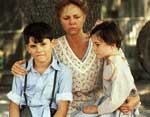 generation. She is ill-prepared to deal with the harsh realities of being a single parent in what is still very much a man’s world. She doesn’t even know how to write out a cheque, much less run a farm and earn a living. Sally Field’s character demonstrates courage, warmth and toughness in the face of overwhelming odds as she attempts to
generation. She is ill-prepared to deal with the harsh realities of being a single parent in what is still very much a man’s world. She doesn’t even know how to write out a cheque, much less run a farm and earn a living. Sally Field’s character demonstrates courage, warmth and toughness in the face of overwhelming odds as she attempts to 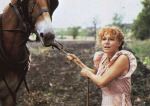 keep her family together during a deep economic and personal crisis.
keep her family together during a deep economic and personal crisis.
Danny Glover’s portrayal of the character Moze, a migrant worker who ends up helping Edna to work the farm and bring in the cotton, captures the essence 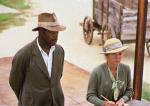 of the situation of the black man in this period of time. Moze searches not only for work to keep body and soul together, but for dignity to make life worth living. He finds both for just a moment with Mizz Spalding on a little farm just outside of the small town of Waxahachie, Texas.
of the situation of the black man in this period of time. Moze searches not only for work to keep body and soul together, but for dignity to make life worth living. He finds both for just a moment with Mizz Spalding on a little farm just outside of the small town of Waxahachie, Texas.
 John Malkovich plays Mr. Will, a complicated character whose injuries from the First Great War involve more than just the loss of his eyesight. As a boarder in the household, Mr. Will temporarily finds a place to belong and a group of people who need him almost as much as he needs to be needed.
John Malkovich plays Mr. Will, a complicated character whose injuries from the First Great War involve more than just the loss of his eyesight. As a boarder in the household, Mr. Will temporarily finds a place to belong and a group of people who need him almost as much as he needs to be needed.
Benton frames his semi-autobiographical work with bookends in the form of two hymns that open and close the film. (See below) These scenes set up a  context for understanding the rest of the action of the film. As with the folksy irregular rhythm of the cotton pickin’ ballads in the middle of the movie, the music comes out of the real life experiences of the townspeople. The music is presented as something that’s a part of what the people here really live. It’s not just an ornamental backdrop for the dramatic action.
context for understanding the rest of the action of the film. As with the folksy irregular rhythm of the cotton pickin’ ballads in the middle of the movie, the music comes out of the real life experiences of the townspeople. The music is presented as something that’s a part of what the people here really live. It’s not just an ornamental backdrop for the dramatic action.
The final scene with the communion in church raises particular issues. Everything else in the film has been firmly anchored in reality until the final frames of the film. Why is it that unreality suddenly takes over? Edna’s dead husband and his killer, the young black man, who was brutally killed by a lynch mob, suddenly appear sitting in church. Sitting there in the pew, they seem as normal as every other member of the community as the communion plate is passed. My thought is that it has to do with what  Robert Benton wants to show us about his main characters and the community they live in. “Places in the Heart” may be a memory of a place and a time that no longer exist. The magic in it is that Benton manages to help us to understand something of what it was like to live there and then, just as he lived it.
Robert Benton wants to show us about his main characters and the community they live in. “Places in the Heart” may be a memory of a place and a time that no longer exist. The magic in it is that Benton manages to help us to understand something of what it was like to live there and then, just as he lived it.
See the TVO Saturday Night at the Movies in depth Interviews as the subject of "Surviving the Depression" is treated in two films shown on SNAM: "Places in the Heart" (1984) and "Pennies from Heaven"(1981).
>>Real Life: Everything in life seemed to be going fine. That all changed the day Tamara learned she had incurable cancer and was faced with only a few uncertain years to live. Where do you turn when confronted with a no-win situation?
>>More to see: Looking for more out of life?
See the framing opening and closing scenes with accompanying music from "Places in the Heart".
Dominick and Eugene (1988)
 “Dominick and Eugene” (1988) has Tom Hulce and Ray Liotta play the parts of twin brothers, one of whom is slightly mentally retarded while the other studies to be a doctor. Hulce plays the slow witted brother. He exchanges comic books with an 11 year old boy on his garbage pick up route, loves pretending he is the Incredible Hulk and has problems remembering his responsibility to walk the dog. The brother played by Ray Liotta is saddled with some of the “adult” concerns of life; trying to plan his medical career, making progress in his love life and keeping his somewhat naïf brother out of trouble with drug dealers, hookers and neighbourhood thugs. Jamie Lee Curtis, the love interest for Gino, finds out that she really doesn’t know what she’s getting into by
“Dominick and Eugene” (1988) has Tom Hulce and Ray Liotta play the parts of twin brothers, one of whom is slightly mentally retarded while the other studies to be a doctor. Hulce plays the slow witted brother. He exchanges comic books with an 11 year old boy on his garbage pick up route, loves pretending he is the Incredible Hulk and has problems remembering his responsibility to walk the dog. The brother played by Ray Liotta is saddled with some of the “adult” concerns of life; trying to plan his medical career, making progress in his love life and keeping his somewhat naïf brother out of trouble with drug dealers, hookers and neighbourhood thugs. Jamie Lee Curtis, the love interest for Gino, finds out that she really doesn’t know what she’s getting into by  getting involved with her fellow medical student. She’s caught in the middle.
getting involved with her fellow medical student. She’s caught in the middle.
There’s a bit to work out in the space of two hours. Some startling revelations relating to manslaughter, child abuse and kidnapping could be interpreted by the overly cynical film critic to be contrived and overly predictable vehicles for sentimentality. I prefer to see the events and the characters as true to life. It may be hard for some to believe, 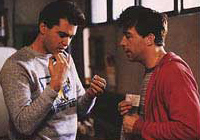 but people like this and situations like this really do exist. I for one have met up with some of them. The interpretation of the movie may rest more with the inner state of mind of the reviewer than the actual skill of the actors, directors and writers involved in the movie making. It’s a film that could go either way. I personally put a full three hankie warning on the film (with lots of nose blowing and tear wiping anticipated for anyone who is the least bit emotionally engaged).
but people like this and situations like this really do exist. I for one have met up with some of them. The interpretation of the movie may rest more with the inner state of mind of the reviewer than the actual skill of the actors, directors and writers involved in the movie making. It’s a film that could go either way. I personally put a full three hankie warning on the film (with lots of nose blowing and tear wiping anticipated for anyone who is the least bit emotionally engaged).
>>More to see: Looking for more out of life?
>>Real Life Story: Jimmy’s working class parents weren’t prepared that day when they sent their teenage son to the corner store. What happens in the families of an innocent victim touched by gang violence?
See a video clip from "Dominick and Eugene" (1988)
Local Hero (1983)
 “Local Hero” (1983) is an offbeat film about an offbeat oil magnate
“Local Hero” (1983) is an offbeat film about an offbeat oil magnate  (Burt Lancaster) who sends his lackey boy (Peter Riegert) to buy a sleepy little fishing village on the coast of Scotland in order to accommodate some of his latest industrial projects. What with the aurora borealis, a pretty biologist named Marina, a canny lawyer slash innkeeper, a roving Russian songster and an odd assortment of townspeople, things get quite off track in short order. Amongst my favourites from the cast of local characters was the right Reverend MacPherson, a pillar of the community who happens to be a black man from Africa.
(Burt Lancaster) who sends his lackey boy (Peter Riegert) to buy a sleepy little fishing village on the coast of Scotland in order to accommodate some of his latest industrial projects. What with the aurora borealis, a pretty biologist named Marina, a canny lawyer slash innkeeper, a roving Russian songster and an odd assortment of townspeople, things get quite off track in short order. Amongst my favourites from the cast of local characters was the right Reverend MacPherson, a pillar of the community who happens to be a black man from Africa.  Equally unexpected is the colourful character of Ben Knox, the eccentric beachcomber whose wise words and unflappable tenacity get the whole show moving in a completely different direction. Thanks to old Ben, it turns out that we see that there might just be something more important in life than money after all.
Equally unexpected is the colourful character of Ben Knox, the eccentric beachcomber whose wise words and unflappable tenacity get the whole show moving in a completely different direction. Thanks to old Ben, it turns out that we see that there might just be something more important in life than money after all.
This film was screened with "Mr. Deeds Goes to Town", also reviewed on Midnight Oil.
<<Back to Midnight Oil main journal
>>On to "Who's Directing Your Life?"
See the video trailer for "Local Hero" (1983)
West is West (1987)
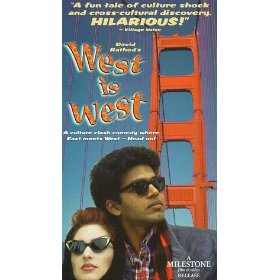 "West is West" (1987) is a bit of an unusual mix. A young Indian man from Bombay shows up in San Francisco intent on gaining admission to the country and to the University of California. Things go terribly amiss and Vikram (Ashutosh Gowariker) ends up living the less than desirable version of the American dream as an illegal immigrant. Bollywood and its stylized vision of life in India is never far away from Vikram's imagination. The American girlfriend, played by Heidi Carpenter, somehow gets incoroporated into the mix (or should I say mix up) and goes from gothic to glamourous (Bollywood style). But it all works somehow.
"West is West" (1987) is a bit of an unusual mix. A young Indian man from Bombay shows up in San Francisco intent on gaining admission to the country and to the University of California. Things go terribly amiss and Vikram (Ashutosh Gowariker) ends up living the less than desirable version of the American dream as an illegal immigrant. Bollywood and its stylized vision of life in India is never far away from Vikram's imagination. The American girlfriend, played by Heidi Carpenter, somehow gets incoroporated into the mix (or should I say mix up) and goes from gothic to glamourous (Bollywood style). But it all works somehow.
It should work because Ashutosh Gowariker has been able to make a success of himself back in India going from actor to writer/director/producer with much critical acclaim. While "West is West" may not be the greatest movie ever, it certainly tells an important story about the immigrant experience that is perhaps not heard often enough in North America.
View the TVO Saturday Night at the Movie Interview segment dealing with the immigrant experience "East Meets West" featuring video clips from "West is West" (1987)
<<Back to Midnight Oil main journal
>>On to "Who's Directing Your Life?"
Coal Miner's Daughter (1980)
 “Coal Miner’s Daughter”(1980) IMDb employs the considerable singing and acting talents of Sissy Spacek along with those of Tommy Lee Jones. As might be expected, the biopic of singing star Loretta Lynn contains a full dose of country and western music. I’m with Doo on this one. I’m normally not partial to country, but I do like Loretta’s singing in this film. Of course the music is not the whole story here in this recounting of the ups and downs of Loretta’s life, but the singing obviously cannot be minimized. The film
“Coal Miner’s Daughter”(1980) IMDb employs the considerable singing and acting talents of Sissy Spacek along with those of Tommy Lee Jones. As might be expected, the biopic of singing star Loretta Lynn contains a full dose of country and western music. I’m with Doo on this one. I’m normally not partial to country, but I do like Loretta’s singing in this film. Of course the music is not the whole story here in this recounting of the ups and downs of Loretta’s life, but the singing obviously cannot be minimized. The film  demonstrates that Loretta Lynn had a wealth of material to draw on from her own life’s experiences to both write and sing from the heart with all those "hurtin’ " songs you heard coming out of the radio.
demonstrates that Loretta Lynn had a wealth of material to draw on from her own life’s experiences to both write and sing from the heart with all those "hurtin’ " songs you heard coming out of the radio.
<<Back to Midnight Oil main journal
>>On to "Who's Directing Your Life?"
Catch the video trailer for “Coal Miner’s Daughter” (1980)





